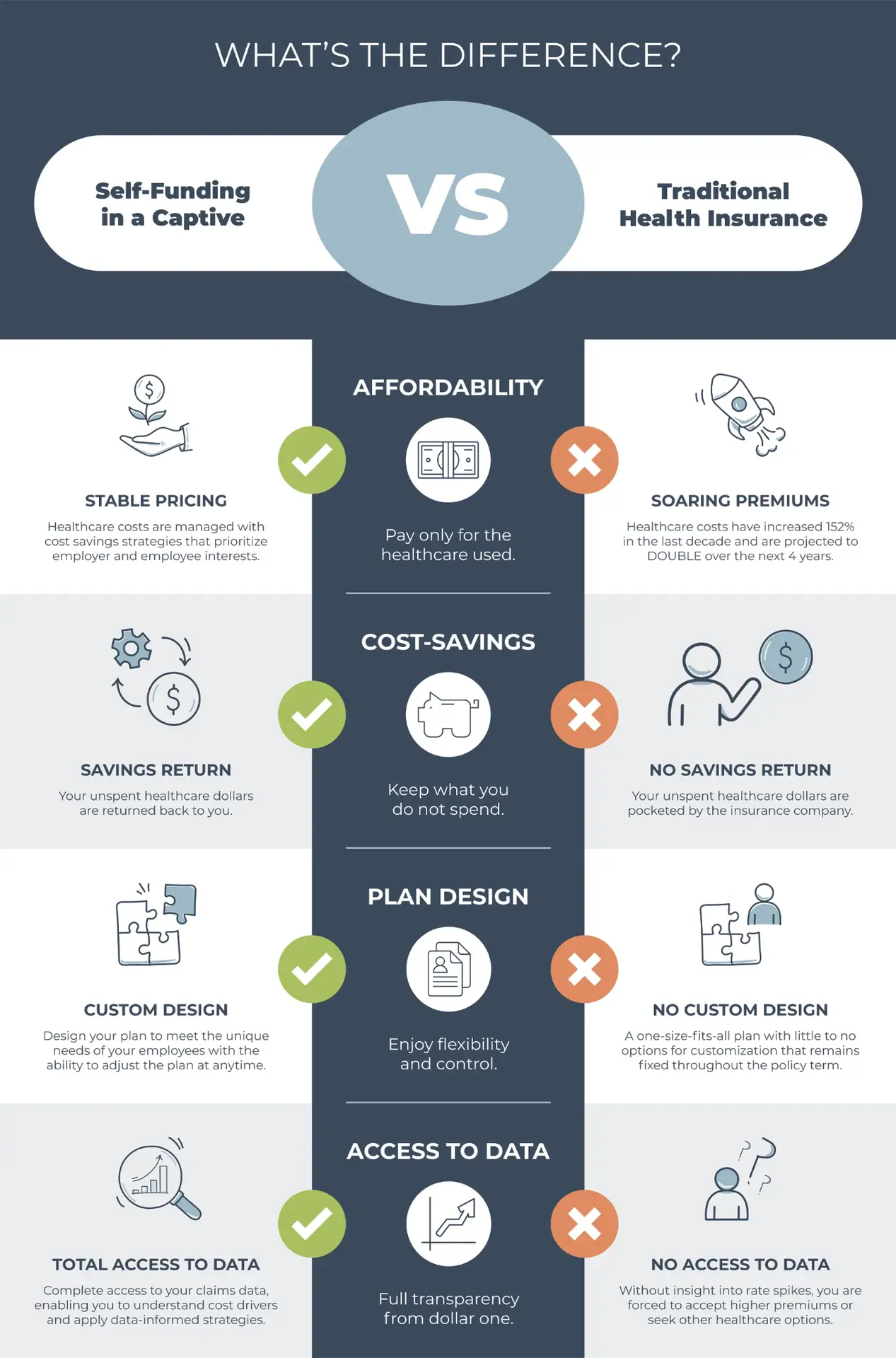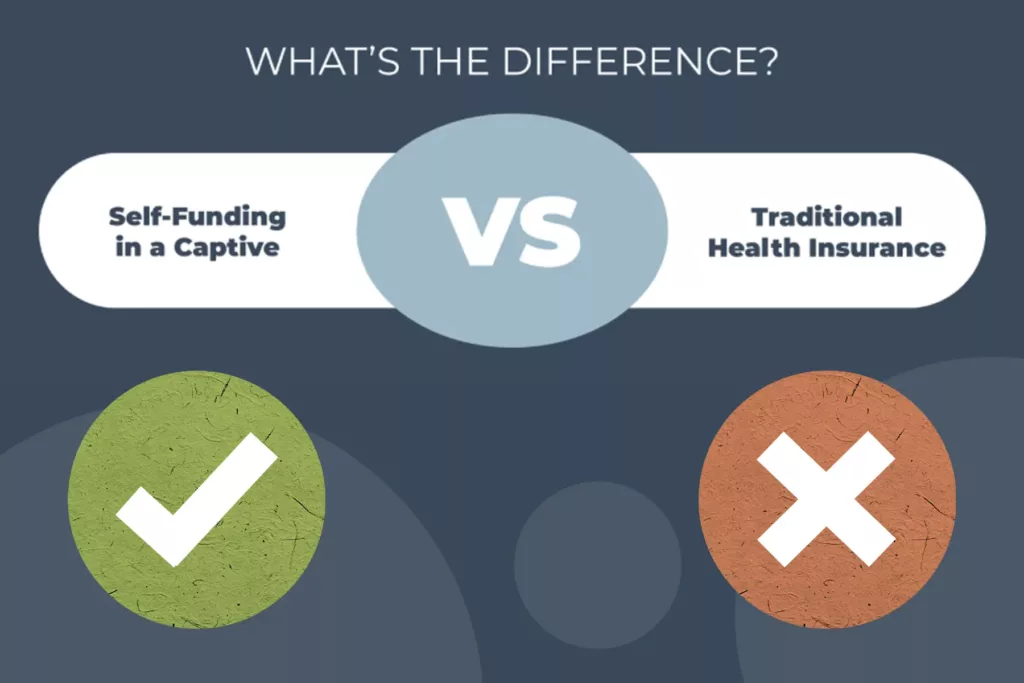Highlights
- Comparing a stop-loss captive vs. traditional insurance plan can help your small business find the most cost-effective employee benefits coverage.
- Traditional insurance can offer 12 months of predictable premium charges but is subject to widely fluctuating price hikes at renewal with little to no control or information as to what is driving costs.
- A stop-loss captive levels the playing field of risk, making self-funding a safe and predictable way for small to midsize businesses to save on premiums and offer better benefits to employees.
- With a stop-loss captive from Roundstone, you benefit from more flexibility and savings while sharing the risk with other group captive members.
- Roundstone’s stop-loss captive lets you save more year over year, helping create a better life for your employees at a reduced cost.
- Stop-loss captives provide actionable data insight so you can optimize your plan to further increase savings.
Until recently, small business owners wanting to provide health insurance had only one option: traditional, fully insured plans. This involved committing to a year-long contract with a major insurer, paying hefty monthly premiums, and adhering to the insurer’s network rules and coverage options. Employers are regularly subject to rate hikes that can sometimes be 20% to 40% higher, year over year.
Small business health insurance is evolving to offer more control and flexibility. Among the new options is the stop-loss captive insurance model, which allows businesses to bypass traditional plan constraints by self-insuring their health insurance, save money, and provide better benefits for their employees.
Understanding the differences between stop-loss captives vs. traditional insurance can help you select the most affordable and effective coverage for your business.
Is self-funding right for your company? Find out in our 30-second quiz:
Thank you for taking the quiz!
What Is Stop-Loss Captive Insurance?
A stop-loss captive, also called a group captive, provides innovative health insurance for small businesses looking to manage health benefits costs more effectively. This model involves small to midsize organizations joining forces in a self-funded group, known as a captive, to collectively share the risk, sidestepping the high costs and limitations associated with traditional insurance plans.
By pooling with other small to midsize businesses, employers with only 25 employees can gain the same risk predictability as a Fortune 500 company and confidently self-fund their health insurance benefits for substantial savings.
As a member of a medical stop-loss captive, you allocate funds specifically to cover your employees’ health claims. This means you only pay for actual claims, potentially lowering costs by avoiding unnecessary coverage. You keep any unused claim spend.
However, this approach requires you to accept the risk of any high-cost or catastrophic claims that may arise. Until recently, it wasn’t a suitable option for small to midsize businesses.
Fortunately, stop-loss insurance provides a safety net when your health claims surpass anticipated amounts, covering the extra costs. Joining a stop-loss captive allows you to share the cost of substantial claims with others, effectively spreading the risk. This approach offers financial protection and allows you to manage health benefits expenses. A stop-loss captive makes self-funding a safe and viable option for small to midsize businesses to save on health insurance.
The benefits of a stop-loss captive include:
- Level risk management. This method helps even out the financial variability caused by large claims, making it easier to manage your health benefits budget with greater predictability.
- Potential for returned savings. If your claims are lower than anticipated, you will see a return on savings because you’re not locked into paying fixed premiums to a traditional insurer.
- Customizable coverage. You have the flexibility to tailor your coverage limits according to your company’s specific needs and your comfort level with risk.
- Enhanced data transparency. Being part of a stop-loss captive gives you deeper insights into your claims because your data belongs to you — not a mega carrier. This empowers you to make data-driven choices about your health benefits plan in ways not possible with traditional insurance. You can implement cost savings strategies to further improve the savings of your self-funded health insurance plan, as well as enhance the quality of care.

Stop-Loss Captives vs. Traditional Insurance: How Are They Different?
With traditional insurance plans, companies commit to fixed monthly premiums paid to an insurance provider in exchange for coverage of employee health claims up to a specified limit.
This ensures health benefit costs are predictable only for the duration of the policy, typically spanning one year. But substantial increases upon renewal are common, as traditional health insurance continues to get more expensive and employers are left to bear the burden.
The plan limits employees to using certain healthcare providers and specifies covered medical services, reducing flexibility. With a fully insured plan, the insurer sets your premiums, which have been rising annually, with a 22% increase since 2018.
Key features and limitations of traditional plans include:
- Fixed premium costs. Your monthly premium stays the same, which means you could end up paying for coverage that goes unused without any possibility of a refund in a low claims year.
- Limited customization. Traditional plans often lack flexibility, which can result in coverage that doesn’t fully align with your employees’ health needs or fit within your budget.
- Standardized coverage. Coverage is fixed, offering limited options for healthcare providers and services.
- Reduced control over claims. The insurance company manages all claims and keeps ownership of your claims data, leaving you with minimal insight or control over handling costs. This can make it challenging to manage expenses or understand the impact of claims on your premiums. And when you do see a hike in your premiums, you are typically given no reason as to why.
- No access to Information. Access to claims or other data offering insight into what is causing the escalation of costs is not available.
Comparing the Models
Comparing traditional insurance with the stop-loss captive model highlights cost differences, predictability, control, and transparency. Here’s an overview comparing the two across these essential categories, providing a clear understanding of each option’s benefits and limitations.

Making the Right Choice for Your Business
Choosing the right insurance plan for your company involves understanding your needs in budget predictability, risk tolerance, and control over your healthcare benefits. To determine which option — traditional insurance or a group captive for stop loss — best suits your business, consider these questions:
- What’s your employee count? Stop-loss captives work best for growing companies with between 25 and 1,000 employees. This size creates a large enough pool to balance out the risk, which helps keep premiums steady. The flexibility also allows for more tailored health benefits as your company expands, leading to better financial outcomes and employee satisfaction with their health coverage.
- How do you view financial risk in relation to healthcare costs? A stop-loss captive can offer savings over time but requires a willingness to assume some amount of risk, though you are protected from the threat of catastrophic claims by stop-loss insurance. If your company’s financial strategy includes a long-term perspective on cost savings and you’re prepared to manage short-term fluctuations, a stop-loss captive could be a great choice.
- Is detailed cost management important to you? Stop-loss captives offer detailed reports on claims and expenses, enabling trend identification and more effective cost management. This information supports the launch of health improvement initiatives for employees, aimed at reducing overall expenses.
- If having access to this data and the ability to act on it is important to your business, a stop-loss captive offers advantages traditional insurance can’t match. You pay what you deserve to pay and can keep any unused claims spend.
- Do you prioritize flexibility in your health benefits? With a stop-loss captive, you can tailor your health benefits to meet the needs of your employees and the business’s financial goals. If flexibility in designing a health plan that reflects your unique culture and values is a priority, the customizable nature of a stop-loss captive could benefit your company.

The Roundstone Advantage: A Proven Solution in Self-Funded Health Insurance
Roundstone is an innovative employee health benefits company. We help small and midsize businesses offer competitive benefits at a lower cost by self-funding health insurance through our group medical captive. The Roundstone Captive enables companies to self-insure safely by pooling hundreds of employers together to share risk and save money.
With easy onboarding and personalized support every step of the way, the Captive offers control, flexibility, and transparency and returns all savings back to employers where they belong. We believe in always aligning with the employers’ best interests and remain committed to our mission — quality, affordable healthcare and a better life for all.
With a stop-loss captive for small businesses from Roundstone, you can see the following benefits:
- Lower operational costs. With Roundstone, you can see reduced operational costs, helping you save more year-over-year. Joining a stop-loss captive lets you and other small businesses negotiate better rates together, easing the financial load of health benefits. This shared risk lowers expenses, giving you major savings without compromising quality.
- Customized plan design. Roundstone offers the flexibility to design a health plan that specifically meets the needs of your employees and your business objectives. You can work with your own Third-Party Administrator (TPA) to design your plan from scratch, including deductibles, co-pays, and network providers, ensuring that your health benefits align perfectly with your company’s unique requirements.
- At Roundstone, we recommend our own in-house TPA, Bywater, but you are free to work with any TPA you choose. We can also recommend other vetted TPAs.
- Superior data analytics for informed decision-making. Roundstone gives you detailed access to your claims data through the CSI Dashboard. This powerful analytics tool lets you control healthcare costs by monitoring where your dollars are going, helping you make informed choices to identify trends and implement health initiatives that directly impact your bottom line.
- Guaranteed savings within the first five years. Roundstone promises you’ll save money within the first five years with our stop-loss captive, showing how much we believe in the model. Our Roundstone Guarantee is backed by an impressive $72 million in returned premiums to customers over 20 years. What’s more, we’re so confident in our product that we use it ourselves!
Experience a New Kind of Coverage With Roundstone
If you’re ready to benefit from increased control, better coverage, and boosted savings, consider a stop-loss captive plan from Roundstone. Our insurance model offers long-term advantages like flexibility, cost containment, and control, helping you create a better life for your employees.
Get your employee benefits through our stop-loss captive plan today and start saving. Speak to a Rounstone team member today to learn more about switching to self-funded insurance.












